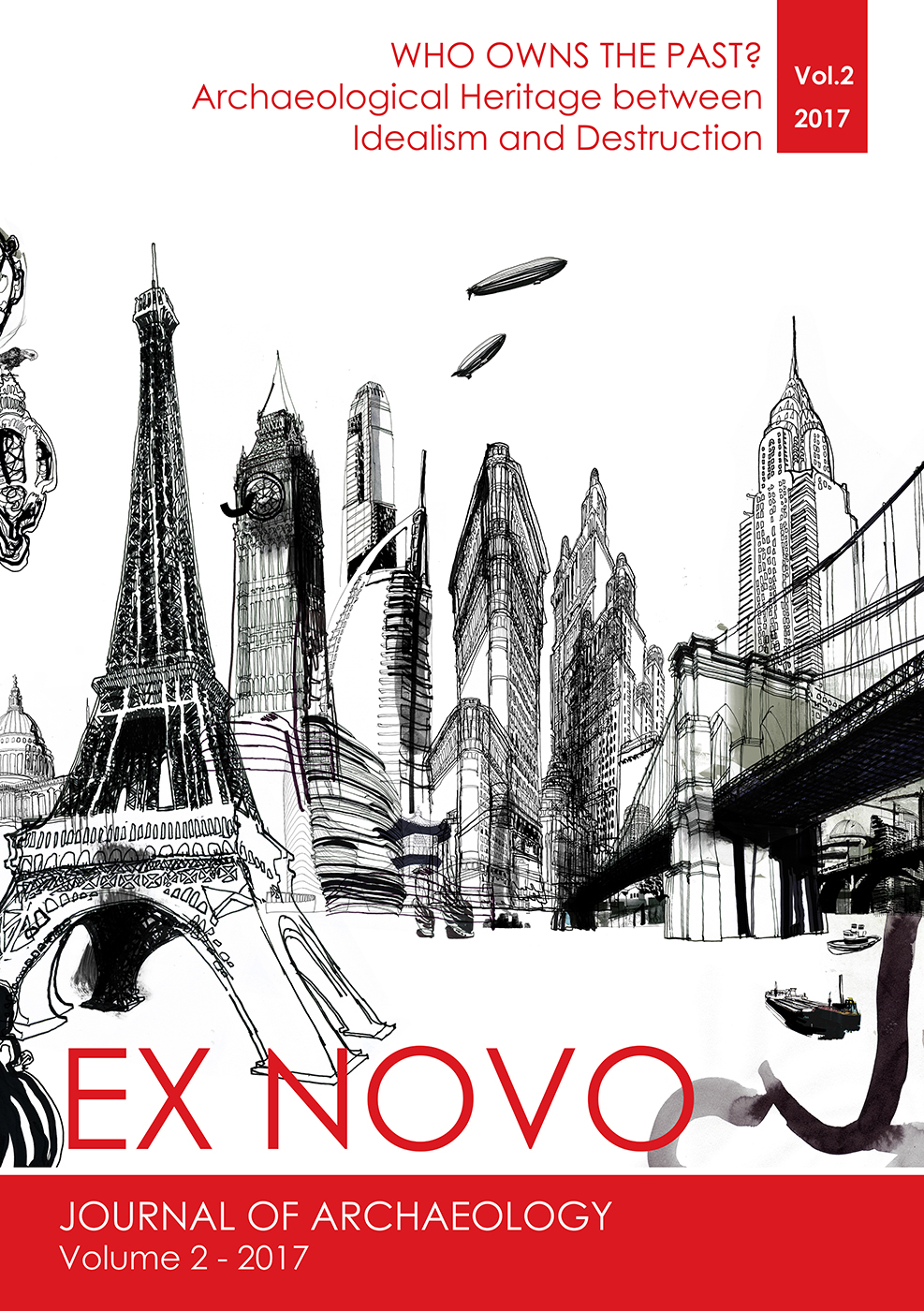The rights of reproducing Cultural Heritage in the digital Era. An Italian Perspective
DOI:
https://doi.org/10.32028/exnovo.v2i0.389Keywords:
IPR, 3D models, Cultural Heritage reproduction, digital assetsAbstract
The spread of digital technology has led to a renewed phase within the debate on property rights in Cultural Heritage reproduction.
This topic is addressed in different ways, but it is currently under discussion both in Europe and USA. Italy holds a particular position in this debate, due to its large concentration of ancient remains and the peculiar structure of its laws.
The interesting experiments of total open access to Cultural Heritage reproduction on the one hand, and claims of the State Administration for control of Cultural Heritage exploitation and a consequent income (in any sense) on the other, are equally valid arguments. At the same time the blurred distinction between the concepts of ‘reconstruction’ and ‘reproduction’, of ‘personal’ and ‘commercial’ use, and the philosophical and mathematical difficulties in defining what is exactly a ‘copy’ in the digital context, make the matter harder.
The paper aims to analyse this debate, and to make a contribution to a new method of considering the economic dimension of Cultural Heritage, taking into account international discussion, while focusing on the situation in Italy, and trying to sum up the needs of the different subjects involved while expressing a proposal to resolve the problem.
References
ADDISON A.C. 2008. Digital Heritage 2.0: Strategies for Safeguarding Culture in a Disappearing World, in: T. A. MIKROPOULOS & N.M. PAPACHRISTOS (eds.), Proceedings International Symposium on "Information and Communication Technologies in Cultural Heritage". Ioannina: Graphic Arts, 9-18.
BELLOTTI F., R. BERTA, A. DE GLORIA, A. D'URSI & V. FIORE, 2012. A serious game model for cultural heritage. Journal of Computing and Cultural Heritage 5: 1-27. https://doi.org/10.1145/2399180.2399185
CALLIERI M., M. DELLEPIANE, P. CIGNONI & R. SCOPIGNO, 2011. Processing Sampled 3D Data: Reconstruction and Visualization Technology, in: F. STANCO, S. BATTIATO & G. GALLO (ed.), Analysis, Restoration, and Reconstruction of Ancient Artworks, Taylor and Francis 2011, 69-89. http://www.crcnetbase.com/doi/abs/10.1201/b11049-4 https://doi.org/10.1201/b11049-3
CASTAGNI N., 2016, Da Ebla a Palmira, tesori feriti al Colosseo. ANSA 07 October 2016. Accessed December 2017. http://www.ansa.it/sito/notizie/cultura/arte/2016/10/07/da-ebla-a-palmira-tesori-feriti-al-colosseo_1fe49ff7-81d3-4bae-a2fa-34cbbbcb8944.html
DEMETRESCU E., B. FANINI, 2017. A white-box framework to oversee archaeological virtual reconstructions in space and time: Methods and tools. Journal of Archaeological Science 14: 500-514. https://doi.org/10.1016/j.jasrep.2017.06.034
DODGSON N.A., 2014, Going to the movies: Lessons from the Film Industry for 3D Libraries, in: M. IOANNIDES, E. QUAK (eds.) 2014. 3D Research Challenges in Cultural Heritage: a Roadmap in Digital Heritage Preservation. Berlin & Heidelberg: Springer. https://doi.org/10.1007/978-3-662-44630-0_7
HARRIS, E.C., 1979. Principles of Archaeological Stratigraphy. London & New York: Academic Press.
HUPPERETZ W., O.E. KAPER, F. NAEREBOUT & M.J. VERSLUYS, 2013. Keys to Rome, Amsterdam: Allard Pierson Museum/WBooks.
LEON, S. 2012, The Revenge of the Yellow Milkmaid: Cultural Heritage Institutions open up dataset of 20m+ items, Open Knowledge international Blog 17 September 2012, Accessed December 2017. https://blog.okfn.org/2012/09/17/the-revenge-of-the-yellow-milkmaid-cultural-heritage-institutions-open-up-dataset-of-20m-items/
PALOMBINI, A., 2016, Open Hardware, Open Space, Open Funding: dal mondo dell'informazione aperta nuovi modelli economici per il patrimonio culturale, in: F. STANCO & G. GALLO (eds.), Proceedings of Archeofoss free, libre and open source software e open format nei processi di ricerca archeologica VIII edizione, Oxford: Archaeopress 2016, 122-127. Accessed December 2017. http://www.archaeopress.com/ArchaeopressShop/Public/download.asp?id={14C6CFBD-3371-4DF0-8971-D4ABC24E661E}
PALOMBINI A., 2014. Flussi turistici e pubblico museale: un tentativo di approccio analitico. Digitalia 9 (2): 38-45.
PEKEL, J., 2014, Democratising the Rijksmuseum. Europeana 27 August 2014. Accessed December 2017. http://pro.europeana.eu/files/Europeana_Professional/Publications/Democratising%20the%20Rijksmuseum.pdf
RAY C., J. VOS & P. RETEL (eds.), 2013. Etruscanning: digital encounters with the Regolini-Galassi Tomb. Amsterdam: University of Amsterdam, Allard Pierson Museum.
REMONDINO F. & S. CAMPANA, 2014, 3D Recording and Modelling in Archaeology and Cultural Heritage. Theory and best practices. BAR International Series 2598. Oxford: Archaeopress. https://doi.org/10.30861/9781407312309
SASSATELLI G. & A. RUSSO TAGLIENTE (eds.), 2014. Il viaggio oltre la vita: gli etruschi e l'Aldilà tra capolavori e realtà virtuale; Bologna: Bononia University Press.
PESCARIN S., (ed.) 2013, Keys to Rome: roman culture and virtual museums, CNR-ITABC. Accessed December 2017, http://keys2rome.eu/downloads/CatalogK2R.pdf
SANDULLI, M.A., 2012. Commentario del Codice per i Beni Culturali e del Paesaggio, Milano: Giuffré Editore.
STUART K., 2010, Assassin's Creed and the appropriation of history, The Guardian 19 November 2010. Accessed December 2017. https://www.theguardian.com/technology/gamesblog/2010/nov/19/assassin-s-creeed-brotherhood-history
VAN RIJMENAM, M., 2017. How Open Data Portals Will Stimulate Innovation and Economic Growth. Datafloq 27 February 2017. Accessed December 2017 https://datafloq.com/read/open-data-portals-stimulate-innovation-economic-gr/94
WALKER, L., 2017. Social Networks that pay users for content. Lifewire (updated: October 2017). Accessed December 2017. https://www.lifewire.com/social-networks-that-pay-users-for-content-2653987
WEINBERG, M., 2016. 3D Scanning, a world without copyright. Shapeways May 2016. Accessed December 2017. https://www.shapeways.com/blog/wp-content/uploads/2016/05/white-paper-3d-scanning-world-without-copyright.pdf






